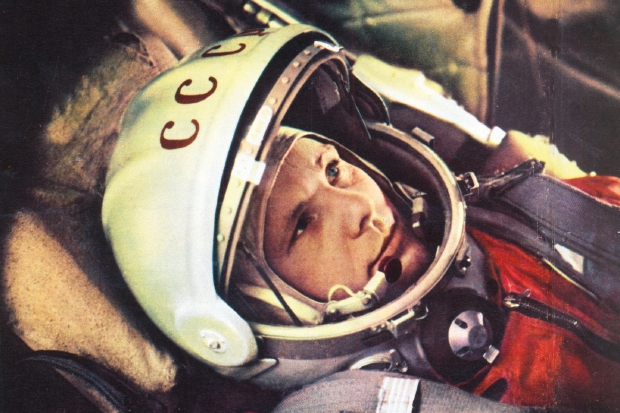‘The dominant narrative of space,’ I was told, in that strange language curators employ, ‘is America.’ Quite so. Kennedy stared at the moon and saw a promotional opportunity. Nasa’s logo was designed by the flamboyant Raymond Loewy. A PR man wrote Neil Armstrong’s unforgettable lines. Every event at Cape Canaveral (later the Kennedy Space Center) was televised, while, in the USSR, Star City was built in furtive secrecy just outside Moscow.
Tom Wolfe glorified the US space programme in The Right Stuff, his boisterous 1979 masterpiece of reportage where the cowboy mentality of the fly-boys co-mingled with the technical marvels of California aerospace, myth-making the while. But the Soviet Union’s space effort was at least as ambitious and just as romantic. It was the Left Stuff.
Cosmonauts is an engrossing new exhibition at the Science Museum. The presentation has a certain clunkiness not inappropriate to the subject, but alert visitors will enjoy a curious mix of pleasures. One, an intense rush of Khrushchev-era nostalgia (who cannot adore the New Soviet Woman?). Two, a delicious, even sublime, voyeurism. (Peering into the claustrophobic clutter of a space capsule, you are very glad not to be there.) Three, a sense of childlike wonder at the audacity of it all (how could that ridiculous thing get to the moon?). Four, and I am not kidding, a reflective mood about the purpose of earthly life. Five, the pure delight of the glorious retro-futurist graphics that the cosmonauts inspired. ‘First in Space! First in Chemistry!’ a poster declares.
The Soviet Union made science a religion and its art suffered. Socialist realist painting was a ham-fisted lie, but vast engineering projects better satisfied the population’s need for symbolism. Significantly, Sergei Korolev, the chief designer of the Soviet space effort, insisted that his 1957 Sputnik, the first artificial satellite, looked good: the little shiny orb, with its trailing antennae, soon became one of the 20th century’s most familiar symbols. Korolev predicted, quite correctly as it turns out, that it would one day be in museums. Here it is in South Kensington.
With Sputnik, and the handsome and personable Yuri Gagarin, the Soviet Union for a while bested an aggrieved United States in the matter of popular modern imagery. Paris Match gleefully declared, ‘The dogma of the USA’s technical superiority has been shattered.’ Maybe, but the cosmonaut programme was founded in ancient Russian mysticism as much as it was fired by rocket science. The very word ‘cosmonautics’ has a speculative sense, suggesting philosophical voyages.
The oppressed Russian soul yearned for escape and found first the metaphor, then the reality, in space travel. Konstantin Tsiolkovsky was making credible jet stratoplane designs and fretting about variable mass systems while the Wright brothers were tinkering with canvas and string. And he was under the influence of Nikolai Fedorov’s crackpot Cosmist movement and his 1906 The Philosophy of the Common Task. This ‘common task’ was to defeat death by achieving immortality for past and future generations.
Cosmic imagery was in the revolutionary air. Kazimir Malevich used interstellar rhetoric in his 1915 Suprematist manifesto: ‘Earth has been abandoned like a worm-eaten house,’ he writes and declares that his pictures expressed ‘an aspiration towards space’. Seen in this light, Malevich’s ‘Black Square’ becomes an awe-inspiring vision of cosmic infinitude. Meanwhile, VladimirTatlin, best known for his unbuilt Monument to the Third International, also designed a space glider.
In 1924 a Society for the Study of Interplanetary Travel was established. The shortcomings of life on earth, it believed, might be escaped in space. A propaganda film by Yakov Protazanov featured Aelita, the Queen of Mars, no less, and explained that it was one’s patriotic duty to dream of space, build rockets and struggle towards a perfect life beyond the surly bonds of Earth’s gravity. Surely all of this, and the secret design bureaus and the lust for domination, inspired Ian Fleming’s Smersh?
The Soviet Union outlawed God, but committed itself to cosmic exploration in search of something else. If the cosmonauts found it, they are not saying. And by 1990, it was all in disarray: Korolev’s own design bureau was working on food-mixers.
Against the contemporary background of Putin’s Russia, the heroic vision of the old Soviet engineers and the bravery of the cosmonauts seem touching and innocent: Alexei Leonov, in 1965 the first space walker, took coloured crayons and paper on his mission.
One of the most haunting images is a 1945 photograph of Sergei Korolev standing on the ruins of Peenemünde, the Baltic Sea bunker of Hitler’s V2 rockets. There he is, dreaming his Soviet dreams of liberation through space travel. For a while, what he imagined was real. We are, alas, more down-to-earth nowadays.






Comments